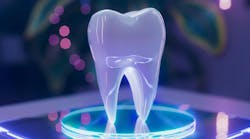Pearls for Your Practice: Smoozies Debonding Kit, MPa Universal Light-Cure Adhesive, DentaSonic IPR System
Smoozies Debonding Kit
Adding clear aligner therapy to my practice has been an amazing experience, adding excitement, satisfaction, and revenue. But it’s come with some conundrums as well. Storing all the aligner cases, how to schedule the delivery appointments, best ways to do interproximal reduction (IPR) … these were all new problems needing solutions. One issue we all face with orthodontic procedures, be they bracket and wire cases or clear aligners, is removing resin at completion. In the Invisalign world, this means removing attachments. Attachments are a must to achieve accurate orthodontic movements, but when I need to remove them, I need to do it fast, safe, and clean. The Smoozies Debonding Kit is my first and only choice for this.
The Smoozies Debonding Kit contains two different kinds of burs and two different polishers. It is designed to remove resin efficiently and gently without scraping, scratching, or damaging enamel. The two burs included in the kit are both carbides in the same shape and size, but one is friction grip and one is latch. The H23VIP debonding carbide is acornshaped and multifluted. It is perfectly shaped for removing Invisalign attachments. I have used the latch version but tend to prefer the friction grip model and use it around 40,000 rpm. I have my assistant periodically pulse some water on the tooth we are removing the attachment on to keep it cool. I like having the bur run dry though, because it helps me see when we have removed all of the attachments.
Once the bulk of the attachment is removed with the H23VIP, I go back to polish with one of two polishers included in the kit. The polishers are the same grit, but one is cup-shaped (9499) and one is flameshaped (9498). I find the flame shape to be the one I pick up most often. These are both latch-type polishers and should be used at a much slower speed than the carbides. I typically run these between 6,000 and 10,000 rpm and I always have my assistant periodically pulse water onto the area. This will smooth and polish the enamel while removing that last layer of resin and adhesive. Komet calls these polishers the “glue eraser,” and that’s what they do.
In general, I can remove 10 to 15 attachments in around two minutes with the Smoozies Debonding Kit. When I am done, the enamel looks pristine with no gouges or scratches. For a busy practice that does a lot of Invisalign, this kit is so key. I used to hate removing attachments, but not anymore. The Smoozies Debonding Kit has been the answer. Solo homerun to right field for Komet!
MPa Universal Light-Cure Adhesive
There is no more important choice in your restorative dental practice than what adhesive agent you use. It is at the heart of almost all of your restorative dental procedures. There are many to choose from and many factors a clinician could use to choose the right system. Dispensing system, flexibility, cost, and ease of use all factor in. When I look for an adhesive system, I want one that has physical properties I can depend on. A great option that fits the bill is MPa Universal Light-Cure Adhesive by Clinician’s Choice.
MPa Universal is a light-cure adhesive bonding system that excels in its physical properties and bond strength. It yields consistently high bond strengths to both dentin and enamel. In addition, MPa Universal provides a consistent dentinal seal that lowers the chances of dealing with the dreaded post-op sensitivity. Part of what generates this great dentinal seal is the low film thickness. At under 10 microns, it is easy to apply and spread around the preparation to ensure an excellent restoration with minimal leakage.
This material is also easy and flexible to work with, opening the door for your etching method of choice. As a universal bonding agent, it will work with any of the three possible etching methods: total-etch, selective-etch, or self-etch. With total-etch, we use phosphoric acid etch across the entire preparation including all the enamel and dentin. MPa Universal generates 21.7 MPa to dentin and 31.6 MPa to enamel. In a selective-etch mode, we only apply phosphoric acid etch to the enamel, letting the self-etch monomers in MPa Universal do the gentle job of etching dentin. Here, this material performs very well, yielding 26.4 MPa bond strength to dentin and 31.6 MPa to enamel. This is my preferred method. In selfetch, we use no phosphoric acid etch at all, only the selfetch monomers within MPa Universal. In this mode, MPa Universal gives a bond strength of 26.4 MPa to dentin and 26.1 MPa to enamel. No matter how you use it, MPa Universal performs well.
MPa Universal is also affordable and comes in both a 5 ml bottle and unit-dose packaging. Clinician’s Choice is a company that has roots in adhesive restorative dentistry. Whether it be with their great True Dental Dam rubber dams, Evanesce composites, or DualForce matrices, they make quality products for restorative dentists. Line drive smash single past the short stop for Clinician’s Choice!
DentaSonic IPR System
Unfortunately, there are some necessary evils involved in dentistry. We have to anesthetize patients. (No one likes that, including clinicians.) We have to prep through the marginal ridge to get to posterior interproximal lesions. (So much good enamel wasted, just because there is no other way to access it!) In clear aligner ortho cases, we often need interproximal reduction (IPR). It’s a necessary evil, but it is one of the few ways that we can resolve crowding issues, especially in adults. When I do IPR, I want it to be fast, accurate, safe, and easy. I have tried a lot of different systems, and the DentaSonic IPR system by GoldenDent works really well in all the ways I need it to.
The DentaSonic IPR System is a reciprocating handpiece system that allows clinicians to quickly and easily perform the prescribed amount of IPR. By “reciprocating,” I mean that the handpiece moves the IPR strip back and forth at around 5,000 rpm. Imagine using a hand strip but being able to automate it with a handpiece. It makes for smooth interproximal reduction without creating a ledge. The kit contains a special reciprocating handpiece and several different insertable strip options.
The handpiece is an E-type electric handpiece and can be used with your electric motor. It should be run at 1:1 gear ratio at around 5,000 rpm. It must be noted that you can only use the DentaSonic handpiece with these strips. The included strips are 0.1 mm, 0.2 mm, 0.3 mm, 0.4 mm, and 0.5 mm. There are also singlesided strips (both right and left) for 0.05 mm, 0.1 mm, and 0.2 mm. Additionally, there are strips just for polishing at the end.
The IPR should start by opening the contact with the 0.1 mm strip. Next, move up to the 0.2 mm until it is passive within the space. Most IPR prescribed for clear aligners is between 0.3 mm and 0.5 mm. Once the 0.2 mm strip is passive, move through the system until you reach the prescribed number. After that strip is passive, just polish with the 15-micron polishing strip. Most contacts should take less than a minute to move through the system. Since they don’t involve a spinning disc, this system is very safe and laceration risk is very low.
I have found that most sessions are five minutes or less with the DentaSonic IPR System. Even if I have six or more sites of IPR, I am in and out of the room in less than five minutes! In addition, I feel safe and comfortable during that IPR time. Deep double to the left field corner for GoldenDent!
Editor's note: This article appeared in the January 2025 print edition of Dental Economics magazine. Dentists in North America are eligible for a complimentary print subscription. Sign up here.









